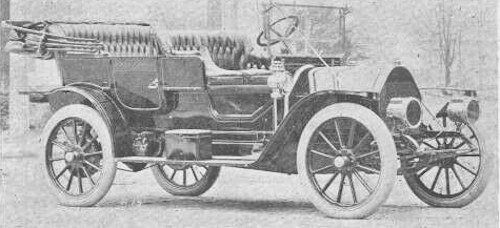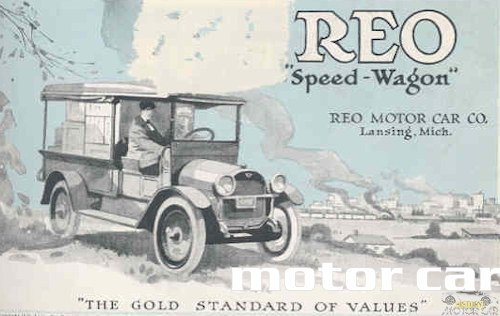REO Motor Car Company

The REO Motor Car Company was an famous American automaker based in Lansing. From 1905 to 1975 .
History
REO at first as RE Olds Motor Car Company ,was founded by Ransom Eli Olds in August 1904. Olds owned 52% of the shares and held the titles of President and Director General. To secure supply of parts, he set up a number of affiliates, including the National Coil Company, the Michigan Screw Company, and the Atlas Drop Forge Company. REO Motor Car Company built passenger cars and trucks also for a short time buses were created.
Initially, the company was known as the "RE Olds Motor Car Company", but the owners of Olds' first company, which was then run by Olds Motor Works, objected to the name and threatened to take legal action as it did not Confusion of names by customers feared. Olds then changed the company name to his initials. The Olds Motor Works soon took over the name of their vehicles, Oldsmobile. So, there were finally no two companies instead of two companies with the company "Olds".
The company was once written with capital letters REO, sometimes only with a large initial letter Reo. In 1907, REO sold goods worth US $ 4,500,000, and the company was one of the four richest automakers in the US. From 1909, however, the market share fell, although Olds constructed better cars, because the competition, By the Ford Motor Company or General Motors Corporation.
REO opened in 1910 a truck division and a Canadian plant in St. Catharine’s (Ontario). Two years later, Olds claimed they built the best possible car, a touring car with 2, 4 or 5 seats, a 30/35 hp engine, a 2,845 mm wheelbase and 32 "wheels for only $ 1,055. plus, windshield and gas tank, which cost US $ 100, extra. The starter cost US $ 25, extra.
Probably the best-known REO episode was the journey across Canada in 1912. The mechanic and driver Fonce V. Haney and journalist Thomas W. Wilby crossed the first time Canada from Halifax (Nova Scotia) to Vancouver (British Columbia), a Distance of 6,720 km, in a REO special touring car of 1912. When the roads in Canada were impassable, they also travelled a short distance through the north-eastern part of Washington.

REO's most famous cars were the REO Flying Cloud, introduced in 1927, and the REO Royale of 1931.
The Flying Cloud was the first car to feature Lockheed's new hydraulically actuated inner brake (drum brake). His styling was designed by Fabio Segardi. While Ned Jordan was credited with changing the advertising style for automobiles with Jordan Playboy's "Somewhere West of Laramie" commercials, the REO Flying Cloud - a name reminiscent of speed and lightness - stands for changing car names. The last car manufactured by REO in 1936 was a flying cloud.
The 1901 REO Royale set design standards by introducing elements that anticipated the streamline for the first time. This model was offered until 1935. Beverly Rae Kimes, in addition to its body designed by the Murray and designed by its chief designer Amos Northup, the Royale also offered customers an inline-eight-cylinder engine with 125 bhp (92 kW) of power, a nine-bearing crankshaft, a new lubrication system and thermostatically controlled radiator flaps. The Royale was ex works with 3,327 mm or 3,429 mm wheelbase; a special model from 1932 had even 3,861 mm wheelbase. Also, the Royale REOs had semi-automatic transmission, the self-shifter
From 1915 to 1925, under Scott's leadership, REO remained profitable. In 1925, however, Scott, like many of his contemporary rivals, embarked on an ambitious expansion program to make the company more competitive through offers in all price categories. This led 1927 also to the introduction of a new mark under the Reo flying cloud, the Wolverine. The vehicle visually appeared as a smaller version of the Flying Cloud with its own radiator grille and hubcaps. It was, however, unlike this, assembled from components of different suppliers ("Assembled Car") and also had an engine purchased from Continental. Sales did not develop satisfactorily and the brand was discontinued in mid-1928. The Wolverine received a slightly longer chassis, a stronger version of the Continental -six and was sold from December 1928 as Reo Flying Cloud Mate; The former Flying Cloud received the additional designation, Master. The failure of the expansion program and the global economic crisis so caused big losses that RE Olds returned to the Executive Board during the year 1933 Already in 1934, he retired. From 1937 REO no longer built passenger cars and concentrated entirely on the production of trucks.
Although the truck orders during the Second World War, the company somehow alive, it was in the post-war period shaky legs, so they tried a bankruptcy and a fresh start. In 1954, the company still did not achieve a satisfactory result and sold all vehicle manufacturing to the Bohn Aluminium and Brass Company in Detroit. Three years later, in 1957, the company became a subsidiary of White Motor Company. White joined REO in 1967 with Diamond T Trucks for Diamond Reo Trucks, Inc. In 1975, this company also had to file for bankruptcy and was completely dissolved.
The band REO Speed wagon derived their name from the light truck REO Speed Wagon, a forerunner of the pickups.

Technical
-
REO History Models (1905-1936)
model
Construction period
cylinder
power
wheelbase
One cylinder
1905-1910
1
7.5-12 bhp (5.5-8.8 kW)
1,862-1,981 mm
Two cylinders
1905-1910
2 row
16-22 bhp (11.8-16.2 kW)
2,235-2,438 mm
Four-24
1906
4 row
24 bhp (17.6 kW)
2,540 mm
Four-35
1910
4 row
35 bhp (26 kW)
2,743 mm
25
1911
4 row
22.5 bhp (16.5 kW)
2,489 mm
30
1911
4 row
30 bhp (22 kW)
2,743 mm
35
1911
4 row
35 bhp (26 kW)
2,743 mm
The Fifth
1912-1919
4 row
35 bhp (26 kW)
2,845-3,048 mm
M
1916-1918
4 row
45 bhp (33 kW)
3,200 mm
T-6
1920-1926
6 row
50 bhp (37 kW)
3,048 mm
Flying Cloud
1927-1928
6 row
65 bhp (48 kW)
3,073 mm
Flying Cloud
1927-1928
6 row
65 bhp (48 kW)
3,073 mm
Flying Cloud Mate
1929
6 row
65 bhp (48 kW)
2,921 mm
Flying Cloud Master
1929
6 row
80 bhp (59 kW)
3,073 mm
Flying Cloud 15
1930-1931
6 row
60 bhp (44 kW)
2,921-2,946 mm
Flying Cloud 20
1930-1931
6 row
80-85 bhp (59-62.5 kW)
3,048 mm
Flying Cloud 25
1930-1931
6 row
80-85 bhp (59-62.5 kW)
3,150 mm
Flying Cloud 30
1931
8 row
125 bhp (92 kW)
3,302 mm
Royale 35
1931
8 row
125 bhp (92 kW)
3,429 mm
Flying Cloud 6-21
1932
6 row
85 bhp (62.5 kW)
3,073 mm
Flying Cloud 8-21
1932
8 row
90 bhp (66 kW)
3,073 mm
Flying Cloud 8-25
1932
8 row
90 bhp (66 kW)
3,175 mm
Royale 8-31
1932
8 row
125 bhp (92 kW)
3,327 mm
Royale 8-35
1932
8 row
125 bhp (92 kW)
3,429 mm
Flying Cloud
1933-1936
6 row
85-95 bhp (62.5-70 kW)
2,921-2,997 mm
Royale 8
1933
8 row
125 bhp (92 kW)
3,327-3,429 mm
Royale 6
1934
6 row
95 bhp (70 kW)
3,327-3,429 mm



